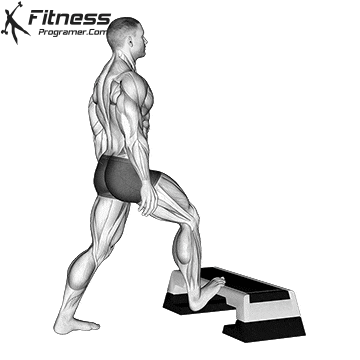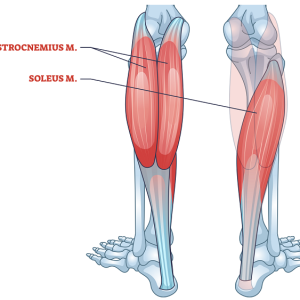Overview
This stretch involves placing the forefoot on an elevated surface, keeping the heel grounded, and leaning forward to lengthen the lower calf and Achilles tendon. The position allows for a controlled stretch in the posterior lower leg while promoting dorsiflexion of the ankle.
It’s a simple, no-equipment-needed stretch that can be used in warm-ups, cool-downs, or rehabilitation programs to support healthy lower limb mechanics. It’s also beneficial for those recovering from Achilles stiffness or looking to prevent overuse injuries.
How to Perform the Standing Toe-Up Achilles Stretch

Setup: Stand in front of a step, platform, or raised surface.
Foot Position: Place the ball of one foot on the edge of the step and the other foot one step back, keeping your heel firmly on the floor. Keep your toes pointing straight ahead.
Lean Forward: Shift your body weight toward the elevated foot until you feel a stretch along the Achilles tendon and lower calf.
Bend the Knee Slightly: This increases the focus on the soleus while still stretching the Achilles tendon.
Hold the Stretch: Maintain for 20–30 seconds, breathing deeply.
Switch Sides: Repeat on the opposite leg.
Tips for Proper Form
Keep the heel down to maintain stretch effectiveness.
Maintain an upright torso to avoid strain on the lower back.
Bend the knee slightly for soleus emphasis; keep it straight for more gastrocnemius involvement.
Avoid excessive leaning—apply a gentle, controlled stretch.
Common Mistakes
Letting the heel lift: Removes tension from the Achilles and calf.
Overstretching: Can strain the Achilles tendon; keep it gentle.
Incorrect toe alignment: Toes should point straight forward for maximum benefit.
Holding the breath: Breathing deeply helps muscles relax.
Benefits of the Standing Toe-Up Achilles Stretch
Improves Achilles tendon flexibility: Reduces stiffness and supports healthy movement patterns.
Increases ankle dorsiflexion: Helps improve squat depth, running stride, and agility.
Targets the soleus and gastrocnemius: Allows for versatile stretching based on knee position.
Reduces injury risk: Flexible tendons and muscles lower the chance of strains or tears.
Aids in recovery: Promotes blood flow to the Achilles tendon for faster healing.
Easy to perform anywhere: Requires only a step, wall, or curb for setup.
How to Incorporate Into Your Routine
For Warm-Ups: Hold for 10–15 seconds per leg to prepare the ankle and calf for activity.
For Cool-Downs: Perform for 20–30 seconds per leg after running, jumping, or leg workouts.
For Mobility Training: Use daily to improve dorsiflexion and Achilles elasticity.
For Injury Prevention: Pair with calf raises to maintain a balance between calf strength and flexibility.
Muscles Worked

Frequently Asked Questions
Should my knee be bent or straight?
Bend the knee slightly for soleus and Achilles focus; keep it straight for more gastrocnemius stretch.
Can I do this every day?
Yes. Gentle stretching daily can improve flexibility and mobility over time.
Is this good for Achilles tendonitis?
It can help relieve mild tightness, but it should be done under guidance if recovering from injury.
How far should I lean?
Lean only until you feel a mild to moderate stretch—never to the point of pain.
Can I do this barefoot?
Yes, barefoot stretching offers better contact and feedback.
